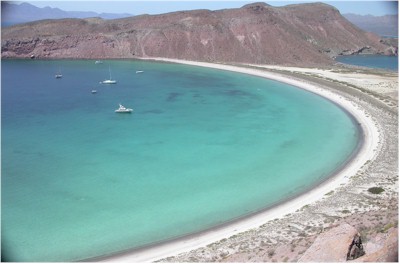
"The Hook" of Isla San Francisco
 |
|
"The Hook" of Isla San Francisco |
At 0200 our second night in Ensenada Grande on Isla Partida we were awakened by a fierce wind shaking our mast and our bow dancing up and down in the growing wind waves. The wind was funneling right into our previously calm anchorage and with it the realization that our nice sleep was over for the night.
We went out on our heaving deck and had a look around; all was clear around us as far as other boats, except now our chain had spread out so we were much closer to the shore. A look at the depth sounder didn't provide good news -- we were now only in 10' of water. We wouldn't be able to let out more chain lest we end up aground, and if our anchor dragged we'd be aground for certain. Knowing this, our only safe option would be to head out of the anchorage. We were consoled by the fact that we now had a nice SW wind to sail us the next 17 or so miles to Isla San Francisco, our next destination, albeit a few days early.
Quickly we got the mainsail ready in case our ailing transmission decided this would be the perfect time to quit (which it was, according to Murphy). There were several large powerboats anchored in front of us, which would have made it extremely difficult for us to tack around should we have to sail out of what seemed now an impossibly dark narrow entrance. Knowing we'd have to get this right, or it would be a night on the beach (isn't cruising fun?), we crossed our fingers, and with our plan of attack ready Sara cranked the anchor chain while Michael had control of the helm.
|
Hiking the ridge of Isla S.F. |
When Michael put the transmission into forward as the anchor chain was coming up, the gears simply made a horrible crunching sound and popped right back into neutral. Thinking quickly, he put the transmission in reverse (which works just fine) just as the anchor was coming up and wouldn't you know -- we backed right out of that anchorage. Plan D or E or something like that, but it got us out of there.
Once well clear of the beach and other anchored boats, Michael fiddled with the transmission some more and finally got the gears to work together with only minor complaints and get Pelican moving forward properly. Clear of the anchorage, we put up the sails in the 15 or so SW knots (dying now, of course) and sailed towards Isla San Francisco. We knew we'd be developing a lot more sailing patience in the next month or so as we head towards San Carlos and our trucking date.
As the sun rose, we set our anchor in the perfectly round bay of Isla San Francisco's southern "hook" in 30 feet of clear emerald water. Another gorgeous spot! We promptly climbed into bed, hoping for a few more zzz's before exploring that day.
Later that day, our anchorage calm as a kitten, we left our noisy outboard on the boat and rowed the inflatable dinghy ashore. That afternoon we explored the beaches which had many interesting shells and rocks, and hiked over the small flat to the beach on the other side of the "hook". The island had fabulous colorful rock formations, beautiful green and red rock and all colors in between in the cliffs and the billions of rocks on the pebbly beach. There are no inhabitants on the island, not even a fish camp and it was beautiful, quiet and pristine, how we'd imagined the Sea of Cortez all these years.
|
Solace sailing up Baja |
One day we hiked along the tall ridge that circled the anchorage and enjoyed breathtaking views of the island and the dramatic tall cliffs and mountains of mainland Baja, and even the islands farther south. Volcanic activity was evident everywhere -- the island appeared as if it had just sprouted out of the sea. At the top of the ridge were giant boulders piled on top of one another, like they'd been set there by a child's hand. The boulders we peered over the edge to look at far down on the beach below proved that the ones perched on the top probably wouldn't remain there forever....
One of our favorite aspects of cruising is to be sitting in a lovely anchorage like Isla San Francisco, and see some friends sail in to join you. Our friends on Tillicum came in one afternoon who we'd last seen in Turtle Bay, way back in November. We'd talked to Robert and Rose over the radio and email the past several months, but it was great seeing and catching up with them in person again. We'll never forget these two colorful Canadians who have sailed thousands of miles as, among many other things, they were the ones we'd talked to that stormy night off Cape Blanco, Oregon and convinced us to sail into the safe harbor of Crescent City.
That same day, Solace sailed in as well who'd we met in La Paz, with their new rescued doggy crew smiling at us later from the dinghy, clearly loving her new life on the water.
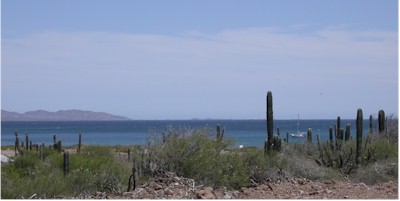 |
|
The cactus of San Evaristo |
A few days later, the wind was blowing what appeared to be about 15 knots from the north so we decided it would be a good day to tack the nine miles north to our next anchorage at San Evaristo up the channel between San Jose Island and mainland Baja. Without turning the engine on, we sailed off our anchor with a reefed main, then put up the jib as we cleared the other anchored boats and headed out for the channel. We weren't too thrilled with what we found as soon as our bow cleared the protection of our anchorage. The wind was not the 15 knots we had in the anchorage, more closer to 30. Which was fine with the sails we had up but the wind had been blowing for about four hours and the waves had time to build to about 4-5 feet, very short and steep. We sailed for about 20 minutes trying to make our way upwind, but heading more due west. The second time the cockpit got pooped with water we knew this was a silly trip and made the decision to just turn around a head right on back to the comfort of our anchorage. It was a good decision as it probably would have taken us the rest of the day to get to San Evaristo, if we could reach it at all sailing against these waves which were making it near impossible to get upwind.
We had a marvelous sail at 7 knots the entire mile back to Isla San Franciso, waves at our stern, and happily settled down to another evening of visiting with friends after sailing back onto our anchor. If nothing else, the day provided a great engineless drill!
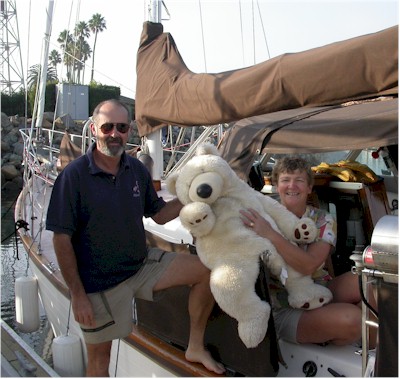 |
|
Our saviors -- Robert and Rose |
The next morning we left at sunrise with Tillicum and Solace, before the northerly winds and waves had a chance to build. It turned out to be the right decision; with a light wind blowing, we made our first tack near the mainland and then the wind picked up during our second trip across the channel. Soon it was blowing 20 knots so we double reefed the main and hoped we didn't need to change our hanked on 120% genoa for the smaller jib as it's always a tiring, wet job. We kept sailing in the still relatively smooth waters, made one more tack near Isla San Jose, then were able to head straight for San Evaristo on the mainland. The morning turned out to be a great fun sail, although not a fast one, as our old, baggy sails just don't go upwind well at all. The sail was highlighted by the stunning mountain scenery on mainland Baja which made us feel like we were sailing up the Grand Canyon.
It is fantastic being able to sail in shorts and t-shirts down here, even on an overcast day such as this one was. The temperatures have been in the 70s, not too hot for sailing in the sun, and in the 60s at night, just right for sleeping under a light blanket. The northerly winds still blowing down the sea have been keeping temperatures fairly cool, but usually just right for us northerners. Every day however feels warmer and warmer and when the wind's not blowing air temperatures will climb quickly into the 80s -- the heat of the desert summer is not far off. But for now we are relishing living and sailing in a minimum of clothing and are not sure we're ready for the shock of the cool Pacific Northwest temperatures when we return in June.
Once safely anchored in San Evaristo, the wind built that whole day and kept blowing through the night; thankfully San Evaristo is well protected from the northerlies. We spent some time exploring the tiny village located there which had salt flats and many goats and donkeys, and a tiny tienda where we bought some fresh chilies.
Waiting for the northerlies to die down so we could continue heading north, Michael got to talking with Robert on Tillicum about our transmission woes again. They hatched the idea that perhaps the forward and reverse clutch plates were identical and could be switched, since the reverse plates were still like new since we obviously don't travel in reverse much (until now that is). Robert has been an auto and boat engine mechanic for about 30 years and we were ecstatic when he told us to bring the transmission over to Tillicum where he'd take a look at it.
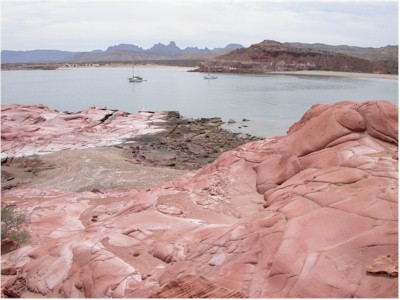 |
|
Puerto Gato's amazing anchorage |
Robert quickly had the tiny transmission apart ("You call this a bastard transmission??" he exclaimed in his jolly Welsh accent when we showed him the child's lunchbox-sized Hurth HBW-50, one of the smallest transmissions the company makes). They found the clutch plates were the same, so switched the visibly worn forward plate with the reverse plate and put the whole thing back together.
Once Michael got the Hurth bolted back on Pelican's Universal a few hours later, he started up the engine, put the gears in forward and vroom we were heading forward without a hint of complaint from our ailing tranny. Success so far! Knowing we'd either be dealing with more northerlies or calm winds on our way north this time of year (the Sea of Cortez is NOT known for it's good sailing winds) we were excited that we'd have a working transmission on our new diesel to make our way up to San Carlos.
The next day we tested the transmission by motoring against some light northerly winds in the afternoon across to an anchorage on the northwest corner of Isla San Jose. Success again! It appears as though (knock on wood) the clutch plate switcharoo worked. That night we had Tillicum over for dinner and showered them with fresh California butter and wine procured in La Paz as meager thanks.
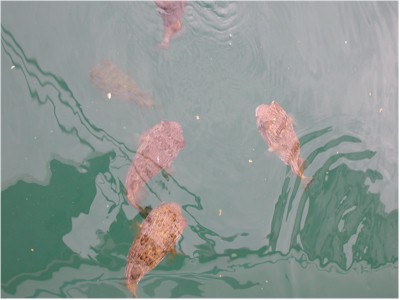 |
|
Puerto Gato visitors -- the porcupine fish |
In the morning, we got to test the transmission again as we motored in glassy seas up to Puerto Gato ("Cat Port"!), a spectacular anchorage back on mainland Baja. On the way, we had a fantastic marine life show as we passed literally hundreds of dolphins traveling south in a long line. Every once in a while a few would break off from the pack, swim over while jumping across the surface to check us out, then swim back to join their dolphin conga line. We also passed a number of whales, and even some jumping giant manta rays. The Gulf of California is brimming with life, except the kind that bite our fishing line apparently as we hadn't caught an edible fish in months. We did catch a small barracuda (yes they have huge teeth!) but read in our fish ID guide that they can have ciguatera toxin, highly poisonous to humans, so threw him back for the larger fish to eat.
We loved the Puerto Gato anchorage; the shore was uninhabited and clean -- our favorite kind of anchorage where we feel like wilderness explorers despite the hundreds of other boats heading up the sea this time of year. Only Tillicum and Pelican were anchored there for most of the afternoon and we explored the beach together. Puerto Gato has the BEST rock formations we'd seen anywhere yet on the trip. Brilliant red sandstone slickrock appeared to tumble along the shore, the kind of smooth, red rock you see in Utah. Really unique of any shoreline we'd seen on the trip yet. So fun to play on the rocks' huge curved smooth surfaces and lounge like a lizard in the sun!
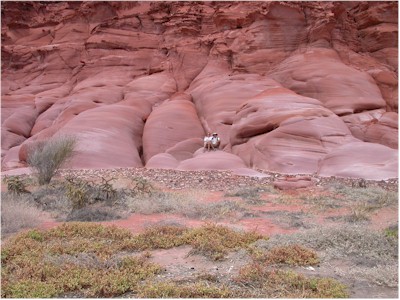 |
|
Lounging on Gato's red rocks |
The water of the anchorage was interesting too -- it was full of porcupine fish who look exactly like that. If you scare them, they will puff all their several inch-long quills out. Most of the fish were about 6 inches long and they would actually gather around the boat if we threw out old crackers or leftovers. The cats loved watching them too! Despite their evil-sounding spines, there are really cute as they only have tiny fins and just kind of bob around in the water, their pursed lips snatching at food bits on the surface.
For the first time in months, since Michael had discovered he'd punctured his ear drum while diving last December, he finally got out his snorkel gear and cleaned off the prop and rudder of growth. Happily his ear is healed now as there is much snorkeling to be done in the Sea of Cortez! Fortunately, all the porcupine fish did was just stare at us as we swam around the boat. They weren't even scared enough to puff up for us! I guess they knew their spines were threatening enough to us humans....
In the afternoon, Manuel, a local panga fisherman came by the boat offering fresh lobster for sale. We gave him $50 pesos (about $5US) for two large ones and enjoyed a feast that night. Life is good so far in the Sea of Cortez.